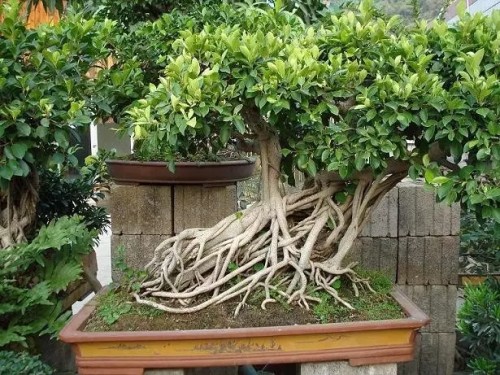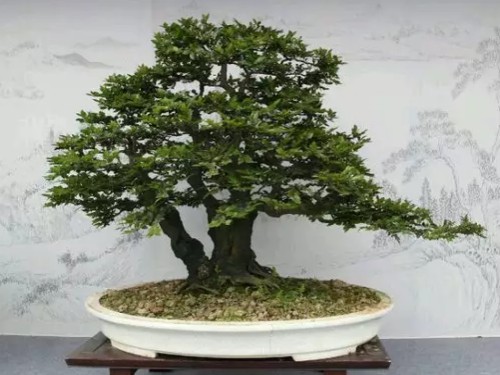How to preserve the bonsai of small leaf banyan
Small-leaf banyan is a common plant in the south, which has thick aerial roots like all banyan plants. These gas roots are very elegant, like hanging curtains, but very firmly directed at the land, the feel is not smooth but full of strength, once buried, it can grow roots, support the continuous extension of the tree crown, and finally form a forest. Why other people's small-leaf banyan can develop bonsai, while your leaves are yellow or withered, the key is water and fertilizer management, as to why they can grow into bonsai, they still need to be trimmed and shaped.

1. Water and fertilizer management
Small leaf banyan is extremely easy to raise, it can adapt to the environment with sufficient fertilizer and water, but also can withstand drought and moisture, and can grow in stone crevices.
If you want to develop bonsai, you must first cultivate the trunk and piles, usually apply thin fertilizer frequently, and use rotten organic fertilizer as topdressing, once every 3 days.
Transplanting and changing pots use mature organic fertilizer as base fertilizer. Only enough fertilizer and water can make the small-leaf banyan grow thick and strong quickly, and only in this way can bonsai be cultivated.
After survival, the banyan tree can accumulate water for a long time, otherwise it is easy to grow only roots and not trunk.
2. Daily pruning
Pruning can have a good-looking shape, small-leaf banyan is also more resistant to pruning, pruning can make the banyan tree reach a very beautiful state.
Small-leaf banyan can be pruned all the year round. A pot of bonsai banyan trees with beautiful appearance are mainly pruned, and they can be tied up without any need.
When it is most prosperous, it can be trimmed twice in a row, mainly to cut short the branches to make the trunk stronger, and the branches at the bottom to be cut off in time.
3. Pick the heart
The purpose of coring is to sprout new buds, this is to promote more branches, and eventually you can get a crown, and pinching buds at the top is very necessary. Picking the heart can also restrain the branches from growing too long and affect their appearance.
The heart-picking of the small-leaf banyan is usually carried out for the first time when there are 3 or 4 leaves.
Wait for the new branch to grow 3 or 4 leaves again, pick the heart in turn, so that the branch will look good.
Finally, you can get a small-leaf banyan with many branches and lush crowns.
4. The importance of thinning buds
Vegetable buds are when trees sprout, often many buds sprout at the same time.
Thinning buds is very necessary for the better growth of small leaf banyan, but also can make the tree shape more beautiful.
Sparse buds actually means that when sprouting at the top of the small leaf banyan node, remove the extra buds and leave one or two appropriate buds.
This can not only reduce the loss of nutrients, but also shape, otherwise multiple small buds grow into branches, which is unsightly.
Tree stump bonsai management in addition to watering, fertilization, pruning, prevention of diseases and insect pests, regular management has more work, such as cleaning work, sunshade, wind protection, cold protection and so on.
1. Cleaning work can not only keep the pile scene clean and beautiful, but also reduce the breeding of diseases and insect pests. Always remove dead branches, fallen leaves and weeds from the potted mouth, wash the dirt from the plate wall, and keep the site where bonsai is placed clean.
2. According to the different requirements of light conditions for different pile landscape tree species, sunshade can be divided into positive and negative tree species, and positive tree species, such as stolen tree, Acer truncatum, pomegranate, crape myrtle, five-needle pine, black pine, juniper, etc., as long as the water supply is proper, although it is exposed to direct sunlight all day, it has no effect on its growth. Negative tree species, such as azaleas, Phyllostachys pubescens, Phyllostachys pubescens, Luohansong, June snow, as well as small pile landscapes and shallow bonsai, should be placed under trees and shade to avoid direct sunlight in summer.
3. Some ancient, tall and cliff-like pile scenes placed in the open air are vulnerable to tropical storms and other strong winds, resulting in serious losses, such as pots, flowerpots falling to the ground, broken branches and so on. Therefore, in order to do a good job in preventing the wind, you can move the pile scene to the flat ground or dump the basin mouth; for some large bonsai which are inconvenient to move, you can set up 1 or 2 pillars and tie the tree poles and thick branches to the pillars to prevent the strong wind from blowing them down.
4. Tree species with poor cold resistance, such as Jiuli incense, Fujian tea, rhododendron, Buddha belly bamboo, etc., should be put into the greenhouse for the winter; those with medium cold tolerance, such as Luohan pine, five-needle pine, sparrow plum, brocade pine, etc., can be set up to guard against cold in the leeward and sunny place, and bury the flowerpot in the soil; the tree species with strong cold tolerance can be placed in the leeward and sunny place, and bury the basin in the soil at the same time.
Time: 2019-06-01 Click:
- Prev

How to maintain the bonsai of black bone tea
Black bone tea, also known as black sandalwood, is a unique tree species near Jiangmen Taishan and Yangjiang in Guangdong Province. it is a newly excavated bonsai tree species in the past decade, because of its small growth range, slow growth, easy to take care of, and artificial cultivation. Things are precious because of scarcity, so they attract people's attention.
- Next

How to turn pots and change soil for tree stump bonsai
After the growth of the stump bonsai for a period of time, the root system is covered with potted soil, crisscross, so that the ability to absorb fertilizer and water is weakened. at the same time, the nutrient elements in the potted soil are less and less, which is disadvantageous to the growth of the stump, so it is necessary to turn the pot and change the soil. The turning of the basin usually takes place in September in autumn or from early spring to Qingming Festival.
Related
- Fuxing push coffee new agricultural production and marketing class: lack of small-scale processing plants
- Jujube rice field leisure farm deep ploughing Yilan for five years to create a space for organic food and play
- Nongyu Farm-A trial of organic papaya for brave women with advanced technology
- Four points for attention in the prevention and control of diseases and insect pests of edible fungi
- How to add nutrient solution to Edible Fungi
- Is there any good way to control edible fungus mites?
- Open Inoculation Technology of Edible Fungi
- Is there any clever way to use fertilizer for edible fungus in winter?
- What agents are used to kill the pathogens of edible fungi in the mushroom shed?
- Rapid drying of Edible Fungi

